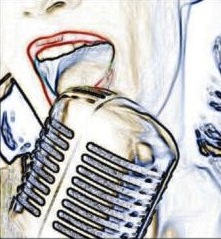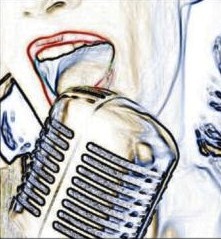All the time and effort you spend on practicing exercises to develop breath control, tone, range and stamina to achieve an emotion-responsive voice is important and should be done. However, much of it can be undone the moment you sing through a mic and your intrinsically acoustic voice becomes an electric instrument. Even with good voice technique a singer needs to adapt to the electronics of mics or suffer loss of the vocal quality they actually have.
11 Mic Tips and Tricks
1. Think of the mic as part of your voice: And think of the monitors as an extension of your ears. Don’t push your voice out, but rather, think of the mic as reaching toward you to receive and amplify your voice.
2. Choose a mic that fits your sound and style: Which model you use will either enhance or detract from the sound of your voice. Mics are designed with their own sound personality. If the mic doesn’t fit the personality of your voice, you can unconsciously tense up throat muscles in an attempt to compensate for the electronic alteration.
A high-pitched vocal tone such as that of DeAndre Brackensick (Top 8 of American Idol Season 11) needs a mic that will reproduce but not accentuate the treble in his voice while adding warmth via the mid and lower tones. A deep, darker voice such as Jermaine Jones (Top 13 of American Idol Season 11) will commonly need a mic designed to accentuate upper mid and treble sparkle so as to eliminate muddiness and help the voice project over the other instruments. Additionally, some mics have more power than others and are best designed for loud bands while others are more sensitive and appropriate for acoustic music or intimate settings.
3. Know how to angle the mic: If you sing into a mic from a wrong angle, your voice will be only partially amplified. Important tonal characteristics will be lost resulting in an inferior sound. Sing into the center of the nose of your mic––not the side or across the top of it. This may take practice, but it pays off in a fuller more present vocal tone.
4. Hold the shaft of the mic, not the head: While some may think it looks cool, holding the head of the mic can muffle the sound of your voice and risk a feedback squeal through the PA. Good mic technique includes holding the shaft of the mic.
5. Work with the Proximity Effect: Mics respond differently depending upon how close or far they are from your mouth when singing loudly or softly. In many cases, a mic will pick up the full quality of your voice best when your mouth is one half to one inch away from it. If you increase your volume drastically, turn your head slightly to the left or right of the mic, or pull the mic slightly farther away and then closer again when you decrease your volume.
6. Don’t be a drifter: Your audience wants to understand what you’re singing. If you move your head away as you taper the volume at the end of your phrase, your voice will drop out of the mix. Keep your mouth directed to the mic through the end of each phrase you sing.
7. Back-off the consonants: Emphasizing most consonants will cause disruptive pops and hisses. Think of your consonants as needing the same amount of air as their accompanying vowel sounds. Vowels ARE the sounds of your voice, consonants are the rhythmic articulators.
The next four tips don’t affect your vocal sound, but are performance tips related to mics and stands:
8. Don’t block your face: Lots of finger tapping on the shaft of your mic while singing is distracting and may cause unwanted, extraneous sounds. Additionally, holding the mic straight in front of your mouth blocks your face and your facial expressions. Instead, angle the shaft of the mic slightly below with the nose pointing up to your mouth.
9. Master your mic stand: Consider your mic stand as a stage prop. You can tilt it, raise it up defiantly or drag it across the stage if that’s appropriate to the emotion of what you’re singing. If you take the mic off, simultaneously move the stand with your other hand so it doesn’t obstruct the audience’s view of you.
10. Release your mic: Your choice of whether to keep the mic on the stand or hold it in your hand can add drama to your performance. When singing with the mic on the stand, feel free to move your arms and hands to enhance visual expression. Hanging onto the mic throughout a song may hamper performance dynamics. An intimately sung line can be expressed physically by touching the mic or simply letting your arms hang by your sides. When singing a more dynamic section of a song, let go of the mic and use your arms for expression.
11. Unwind your mic cord: I’ve seen singers grab the mic off the stand only to have it, along with the mic, topple to the floor. This embarrassing calamity was due to the mic cord being wound around the stand. At band set-up, live sound engineers often wind cables around mic stands. If you like taking your wired mic off the stand, don’t forget to unwind the cable from the stand before you start your set so it’s a fast and seamless transition from stand to hand.
 miniBIO: Jeannie Deva is recognized internationally as a top celebrity voice and performance coach. Her private studios are in Brentwood and Los Angeles, CA. As a recording studio vocal specialist, she’s been endorsed by producers and engineers for Aerosmith, Elton John, Fleetwood Mac and the Rolling Stones. Her latest book is Singer’s Guide to Powerful Performances. Visit http://jeanniedeva.com • http://facebook.com/jeanniedeva • @JeannieDeva
miniBIO: Jeannie Deva is recognized internationally as a top celebrity voice and performance coach. Her private studios are in Brentwood and Los Angeles, CA. As a recording studio vocal specialist, she’s been endorsed by producers and engineers for Aerosmith, Elton John, Fleetwood Mac and the Rolling Stones. Her latest book is Singer’s Guide to Powerful Performances. Visit http://jeanniedeva.com • http://facebook.com/jeanniedeva • @JeannieDeva










